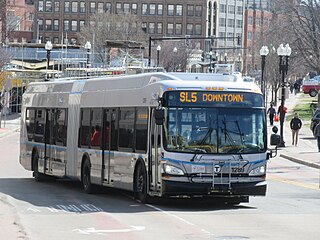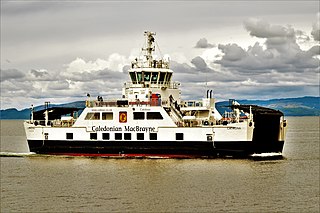
An electric boat is a powered watercraft driven by electric motors, which are powered by either on-board battery packs, solar panels or generators.
A ferry is a watercraft that carries passengers, and sometimes vehicles and cargo, across a body of water. A small passenger ferry with many stops, such as in Venice, Italy, is sometimes called a water taxi or water bus.

A hybrid vehicle is one that uses two or more distinct types of power, such as submarines that use diesel when surfaced and batteries when submerged. Other means to store energy include pressurized fluid in hydraulic hybrids.

An electric truck is an electric vehicle powered by batteries designed to transport cargo, carry specialized payloads, or perform other utilitarian work.
Scandlines is a ferry company that operates the Rødby–Puttgarden and Gedser–Rostock ferry routes between Denmark and Germany.

A rotor ship is a type of ship designed to use the Magnus effect for propulsion. The ship is propelled, at least in part, by large powered vertical rotors, sometimes known as rotor sails. German engineer Anton Flettner was the first to build a ship that attempted to tap this force for propulsion, and ships using his type of rotor are sometimes known as Flettner ships.

The Caledonian MacBrayne fleet is the largest fleet of car and passenger ferries in the United Kingdom, with 34 ferries in operation, 2 on charter and another 6 on order. The company provides lifeline services to 23 islands off the west coast of Scotland, as well as operating routes in the Firth of Clyde.

Ferguson Marine Limited is a shipbuilding company whose yard, located in Port Glasgow on the Firth of Clyde in Scotland, was established in 1903. It is the last remaining shipbuilder on the lower Clyde and is currently the only builder of merchant ships on the river. For some years the company's mainstay has been Roll-on/roll-off ferries, primarily for Caledonian MacBrayne (CalMac), including a series of innovative hybrid diesel-electric/battery-powered vessels. Beset with difficulties since 2018 over their latest two CalMac ferries, Fergusons' largest ever vessel, the shipyard was nationalised in December 2019. It is now classified as an executive non-departmental public body of the Scottish Government.

A hybrid electric vehicle (HEV) is a type of hybrid vehicle that combines a conventional internal combustion engine (ICE) system with an electric propulsion system. The presence of the electric powertrain is intended to achieve either better fuel economy than a conventional vehicle or better performance. There is a variety of HEV types and the degree to which each function as an electric vehicle (EV) also varies. The most common form of HEV is the hybrid electric car, although hybrid electric trucks, buses, boats and aircraft also exist.

Marine propulsion is the mechanism or system used to generate thrust to move a watercraft through water. While paddles and sails are still used on some smaller boats, most modern ships are propelled by mechanical systems consisting of an electric motor or internal combustion engine driving a propeller, or less frequently, in pump-jets, an impeller. Marine engineering is the discipline concerned with the engineering design process of marine propulsion systems.
The Hornblower Hybrid is a family of ferry boats belonging to US operator Hornblower Cruises, which are powered with hybrid power trains.
Hornblower Cruises is a San Francisco–based charter yacht, dining cruise and ferry service company. In 2021, the company rebranded most of its services as City Cruises or City Experiences.

Caledonian Maritime Assets Limited owns the ferries, ports, harbours and infrastructure for the ferry services serving the west coast of Scotland, the Firth of Clyde and the Northern Isles.

MV Lochinvar is a pioneering diesel electric hybrid ferry built for Caledonian MacBrayne. Initially, she operated between Tarbert and Portavadie, was moved to the Mallaig to Armadale route in 2016 and currently operates on the Lochaline to Fishnish route. She is one of only three passenger and vehicle roll-on, roll-off ferries in the world to incorporate a low-carbon hybrid system of diesel electric and lithium ion battery power and is the second hybrid ferry commissioned and owned by Caledonian Maritime Assets. The ferries are sea-going and are 43.5 m (143 ft) long, accommodating 150 passengers, 23 cars or two HGVs. The first ferry, MV Hallaig, entered service on the Sconser to Raasay route in October 2013. The third sister ship, MV Catriona, entered service in 2016.

MV Catriona is a pioneering diesel electric hybrid passenger and vehicle roll-on, roll-off ferry built for Caledonian MacBrayne for the Claonaig–Lochranza crossing. She is the third hybrid ferry commissioned and owned by Caledonian Maritime Assets, one of three such ferries in the world to incorporate a low-carbon hybrid system of diesel electric and lithium ion battery power. The ferries are sea-going and are nearly 46 metres (150 ft) long, accommodating 150 passengers, 23 cars or two HGVs.

MV Victoria of Wight is a ship sailing on the Portsmouth to Fishbourne route operated by Wightlink. She entered service on 26 August 2018. Built by the Cemre Shipyard in Yalova for £30 million, she is the newest ship in the fleet and completed Wightlink's £45 million investment in the Portsmouth to Fishbourne route. In addition, upon introduction into service Victoria of Wight became the largest ship in the fleet and the new flagship.

MV Loch Frisa is a ferry bought by Caledonian Maritime Assets for operation by Caledonian MacBrayne to serve between Oban and Craignure. She was originally named MV Utne and operated by Norled from 2015 to 2021. In December 2021, following a naming competition, CMAL announced her renaming as MV Loch Frisa.
The manufacture, sale, and adoption of electric vehicles in Thailand is supported by the Thai government, in order to reduce carbon emissions and air pollution. Prime Minister Prayut Chan-o-cha appointed the National Electric Vehicle Policy Committee in February 2020 to set targets for zero emission vehicle adoption. The government has announced aims for 30% of automobiles produced in 2030 to be electric, and to become a regional hub for electric vehicle manufacturing.
Cemre Shipyard is a shipyard in Altınova, on the shore of the Sea of Marmara in Yalova Province, Turkey. Established in 2005, they now specialise in low- and zero-emission, battery and hybrid vessels for the world market.
MV Sea Change is first hydrogen fuel cell vessel in the United States and the first commercial fuel cell ferry in the world.













